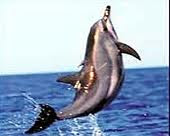Last Jun 19, on the post labeled “Costa Rica one of the Top favorite spots for Humpback Whales”; I miss the opportunity of giving enough attention to one of my favorite friends of all times “Flipper”.
I bet you remember, grew up, or heard your parents talking about this amazing Dolphin.
Flipper belongs to one of the species that live in Costa Rica, the Bottlenose Dolphin
There are Four Species of Dolphins living in the waters off the southern Pacific Coast of Costa Rica:
Bottlenose (Flipper)
Common Dolphin
Spinner
Spotted
Quite honestly, not too long ago I tended to believe that all dolphins were made equal; from my point of view, a dolphin was a dolphin, and that was all. Then, when we decided to live in a power yacht in San Diego and go fishing as often as we could, I started to realize that if you look closely, you could see many differences among them. Now, here in Costa Rica I am delighted to see that there are four species living in these waters full time.
Bottlenose Dolphins:
One of Costa Rica’s most frequently sighted dolphins is the playful bottlenose (Tursiops truncates); most bottlenose dolphins living in Costa Rican waters are on the smaller side, weighing less than 1,000 pounds. Males are typically longer and heavier as adults, but females grow more quickly within the first 10 years.
The upper bodies of bottlenose dolphins are very flexible because five of their seven neck vertebrae are not fused together.
Their outfit is designed to serve as camouflage against predators, and that is the reason why the colors range from light gray to dark gray on their backs and pale pink or light gray on the belly.
They often hunt in groups and use echolocation to find as well as to herd their prey; it is quite common to see them near fishing boats. They seem to love to escort ships, often pacing themselves next to the bow.
These highly intelligent and social mammals use distinctive whistles and clicks to communicate with other dolphins in their group.
Bottlenose dolphins live in open societies, and that means their social choices within their group can change daily.
Dolphins are fast swimmers and can reach speeds of 19 miles per hour.
The specie is found worldwide in temperate and tropical waters, they are not considered endangered species; however, in some areas they seem to be close to total depletion.
In Costa Rica, dolphins are typically spotted year-round along both coasts.
Common Dolphin:
This type of dolphin is the one we find performing in Sea World, San Diego
This dolphin is found more often in the open ocean, but sometimes swims in shallow waters.
This common dolphin lives in both tropical and temperate waters.
This dolphin is found more often in the open ocean, but sometimes swims in shallow waters.
This common dolphin lives in both tropical and temperate waters.
In Costa Rica, it is found on the Pacific side, especially the coasts of Guanacaste, the Osa Peninsula, and Golfo Dulce.
The common dolphin has an elongate body with a black or blackish brown V-shaped patch on the back and white underside. The snout is black with white spots, and there are several dark lines on the face and extending from the lower jaw to the flippers. There are long white areas along the sides of the body as well. The dorsal fin is triangular and dark, the flippers sharp and pointed, and the flukes gray or black with a center notch.
The common dolphin has an elongate body with a black or blackish brown V-shaped patch on the back and white underside. The snout is black with white spots, and there are several dark lines on the face and extending from the lower jaw to the flippers. There are long white areas along the sides of the body as well. The dorsal fin is triangular and dark, the flippers sharp and pointed, and the flukes gray or black with a center notch.
This dolphin is not only common, but also is the most gregarious of dolphins; it is frequently found in herds with hundreds of individuals, and in the Black Sea can be found in masses of 300,000 because there is a concentration of fish high enough to support so many dolphins.
This dolphin can dive 900 feet deep and stay underwater for up to 8 minutes; it is a fast swimmer on the surface of the water, reaching speeds of 28 miles per hour.
You can see these dolphins swimming alongside small boats or riding the waves before the bow.
Common Dolphins also use echolocation and many vocalizations to communicate with each other.
This kind of dolphin can be considered affectionate, because they often help sick common dolphins to stay afloat to breathe.
The common dolphin eats a variety of fish, such as sardines, anchovies, and herrings, as well as squid and octopus. It eats over 80 lb of food every day.
This dolphin reaches lengths of 8 ft. and weighs 220-290 lb; the male is slightly larger. Fishermen often look for them feeding to locate tuna and other pelagic species. It’s interesting to notice the fishermen are looking for the dolphins and the dolphins are looking for fishermen with the same goal in mind. Finding the fish.
This dolphin reaches lengths of 8 ft. and weighs 220-290 lb; the male is slightly larger. Fishermen often look for them feeding to locate tuna and other pelagic species. It’s interesting to notice the fishermen are looking for the dolphins and the dolphins are looking for fishermen with the same goal in mind. Finding the fish.
Spinner Dolphin:
The spinner dolphin, (Stenella longirostris), is found all over the world.
Costa Rican spinner dolphins are found in large schools in coastal waters off the west coast of Central America.
The Eastern spinner also inhabits the waters off the west coast of Central America, but farther offshore in deeper waters than the Costa Rican spinner. The Eastern spinner is also found in deep waters off the coast of Mexico. This subspecies also travels in very large schools of thousands.
The spinner dolphin, has a long snout, and measures about 6.5 ft. in length and weighs about 200 lb. They have small, pointed flippers and a curved dorsal fin at the center of the body. Spinner dolphins are dark gray on the dorsal side with a lighter gray area that runs from the eyes to the tail. The ventral side is white.
The Costa Rican spinner, (S. longirostris centroamericana) is one of the four subspecies of spinner dolphins; the other three are
1. Gray's spinner, (S. longirostris longirostris)
2. Eastern white-belly spinner, (S. longirostris orientalis)
3. Dwarf spinner dolphin, (S. longirostris roseiventris)
1. Gray's spinner, (S. longirostris longirostris)
2. Eastern white-belly spinner, (S. longirostris orientalis)
3. Dwarf spinner dolphin, (S. longirostris roseiventris)
 Spinner dolphins are a very gregarious species frequently traveling together in schools and with other species, such as the spotted dolphin and humpback whales. In the eastern tropical Pacific, spinner dolphins swim with Yellowfin tuna, which has resulted in great numbers of spinner dolphins caught as by catch.
Spinner dolphins are a very gregarious species frequently traveling together in schools and with other species, such as the spotted dolphin and humpback whales. In the eastern tropical Pacific, spinner dolphins swim with Yellowfin tuna, which has resulted in great numbers of spinner dolphins caught as by catch.The characteristic spinning of this species seems to be part of their communication especially when the members of the school are scattered. Another theory is that the spinning may be related to the removal of parasites or of remoras, a fish species that a type of fish with a modifiedused to attach itself by suction to marine life for the removal of parasites.
In either case, once you see a dolphin spinning, that pictures will always be in your mind. They look like they are having the time of their lives. These guys really know how to party.
Spotted Dolphin:
In Costa Rica, this dolphin can be found in the waters along the Pacific coast, and is especially common in Golfo Dulce.
This sleek, long dolphin has a distinct coloration. Its back is covered in a dark gray patch of skin or "saddle' that spreads from its front to past the dorsal fin. Small white spots cover the dark area, and dark spots speckle the creamy white belly. It also has a dark patch over the eyes and several other distinct dark lines on the face and body. The dorsal fin is curved and the flukes and flippers are small and pointed. The size of the spotted dolphin can vary, but individuals in coastal populations tend to be larger.
These dolphins can gather in groups of 1,000 or more individuals, especially in offshore populations, but groups of a few hundred are more common to find. Coastal populations tend to be smaller, numbering 50 or fewer individuals. Spotted dolphin pods include both sexes and all ages, and sometimes they blend schools with other dolphin species as well, such as the spinner dolphin. These agile dolphins can swim up to 18 miles per hour and may speed next to boats, performing acrobatic leaps. Unfortunately, thousands are killed every year in nets of men fishing for yellow fin tuna. Because the spotted dolphin's diet is similar to this tuna, the dolphins are often with them, and sometimes anglers purposefully follow the dolphins to the get to the school of tuna and subsequently pull them in with the catch.
Spotted dolphins prey on squid and at least 18 species of fish.
Adults reach lengths of around 8 ft., and weigh between 200 and 360 lb.; males are larger than females, but females have a larger snout.
Spotted dolphins prey on squid and at least 18 species of fish.
Adults reach lengths of around 8 ft., and weigh between 200 and 360 lb.; males are larger than females, but females have a larger snout.
After reading and seeing how different dolphins can be depending on their species, I bet you would like to see them in person, and why not to come to Costa Rica and take one of the tours offered by this experienced tour operator: Bahia Aventuras, located in the beautiful Uvita beach. Visit their web site for more information:
www.bahiaaventuras.com/about/team-bahia-aventuras
www.bahiaaventuras.com/about/team-bahia-aventuras
Now you will be able to tell what kind of dolphin you are looking at, and even though not all of them are Flipper, all of them will plant in your heart the spark of Joy and Beauty that simple things bring to our lives every day, and more often than not, we manage to overlook.
Let the dolphins bring your happy childhood memories into play.







